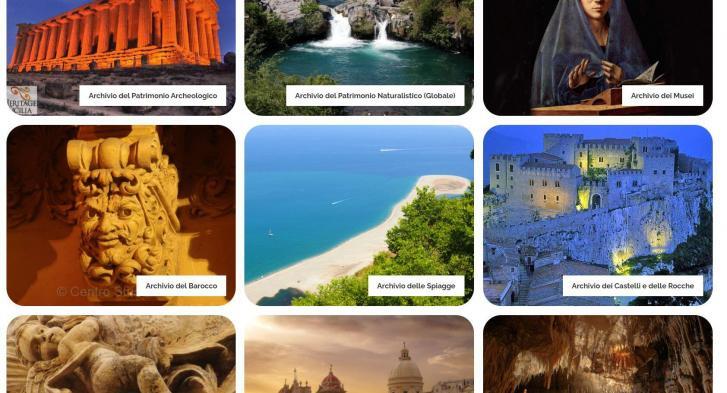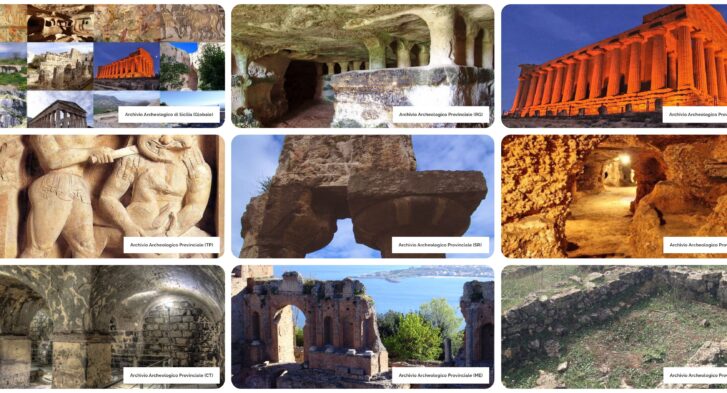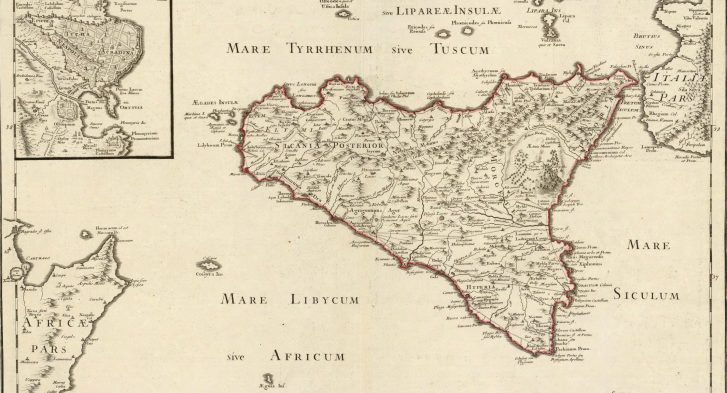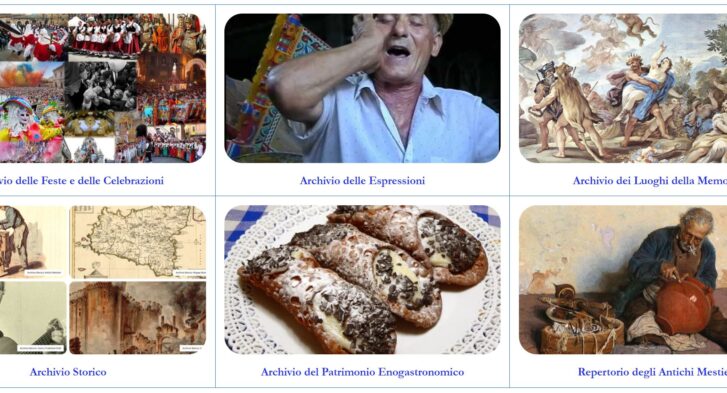Dionysus (Free)
by Ignazio Caloggero
Origins of the Myth
Reference page: Repertory of Cults and Myths
The cult of Dionysus is very ancient, his name is already found in a Cretan tablet from the XNUMXnd millennium BC
Dionysus is probably seen as the "son of God". In the Thraco-Phrygian language "nusos", in fact, means "son" [Ambrogio Donini: Brief history of religions. p. 140].
Dionysus was fundamentally the protector of vegetation, in particular of the vine and, therefore, of wine. Also called Bacchus, he was identified by the Romans with the Italic god Liber Pater from which he took the name of Libero. The cult of him, as well as that of the Palici, is considered servile, therefore of a popular nature.
Its legend is quite complex, in fact it is an interweaving of Greek elements and elements of countries close to Greece such as Thrace and Phrygia (region of Turkey, in the north-western part of Anatolia). Mount Nisa, where according to tradition Dionysus was born, is found in various countries: in Thrace, Arabia, India and Egypt; and cities with this name are remembered in Thrace, Euboea, Asia and Africa [EWStoll: Handbook of the religions and mythology of the Greeks and Romans. p. 136.].
There are several variants on the birth of Dionysus. According to one of these, Dionysus would be the son of Zeus and Persephone. In fact, it is said that Demeter he hid his daughter Persephone in a cave in Sicily, entrusting her to the custody of two snakes; Zeus then transformed into a snake and managed to mate with Persephone generating Dionysus who was born inside the same cave and had his head adorned with two horns. According to the second variant, Dionysus would be the son of Zeus and the Theban Semele [Diodorus lib IV.4].

Caravaggio: Bacchus (c. 1595 – Uffizi Gallery, Florence)
During love affairs, Zeus presented himself to Semele in the guise of a common mortal. Hera, having learned of her husband's umpteenth betrayal, wanted to take revenge on her rival who was already six months pregnant and assumed the appearance of Semele's nurse, instilled in her the doubt that her lover was not the god Zeus, advising her, in order to accept it, to ask Zeus for an embrace in which he presents himself in the real divine guise and no longer in the guise of a common mortal. Semele, having fallen into her trap, asked Zeus to show himself to her in all her divine splendor and the god, to please her, granted her wish but, at the sight of so much splendour, poor Semele fell electrocuted. Zeus then stole the baby that Semele was carrying and helped by Hephaestus (who had already had the opportunity to operate as an obstetrician, on the occasion of the birth of Athena) had the baby sewn on his thigh, thus completing the gestation himself. Thus was born Dionysus, the twice-born god.
Legend has it that Dionysus joined the Cretan Ariadne, the daughter of Minos who followed Theseus after he had killed the Minotaur. Theseus abandoned Ariadne on the island of Nasso, here she was seen by Dionysus who fell in love with her and made her his wife after obtaining immortality for her from Zeus [Pausanias Lib. I, 20,3].
Many journeys are attributed to Dionysus. It is said that during one of these trips, he was kidnapped by Etruscan pirates who wanted to sell him as a slave in Asia. The god then transformed the pirates' oars into serpents, covered the ship with ivy and made every point of the ship resound with music from invisible flutes, and finally paralyzed the ship with garlands of vines. The sailors, mad, threw themselves into the sea where they turned into dolphins. It is from this legend that the belief was born according to which dolphins are friends of men and try to save them from shipwrecks: they would be the repentant pirates of the legend of Dionysus.
Dionysus' travels also affected Sicily, where he met, or rather collided with Alpo, a Sicilian giant. Alpo lived in the Peloritani mountains, he had many arms and his hair was made up of a hundred vipers. His favorite pastime was to wait for travelers who got lost in the gorges of the mountain, he crushed them by throwing large boulders and finally devoured them. The mountain where the giant lived remained, therefore, always deserted because no one had the courage to venture into those places. This situation lasted until Dionysus, during one of his many trips, decided to stop by those parts. Alpo, as soon as he saw him, attacked him using whole trees as weapons and a large boulder as a shield. Dionysus, to defend himself, threw his thyrsus against him which reached him straight down his throat, killing him and thus freeing the mountain which could be populated again.
Among the attributes associated with Dionysus is the rod. About this Diodorus Siculus (Lib. IV.4) gives the following explanation:
"When wine was first discovered it was not thought of mixing it with water, so the wine was drunk pure, but when some friends, gathered together, went mad because of the abundance of wine drunk pure, they used their wooden sticks to hit each other. Consequently, since some were injured and others received fatal wounds in vital points, Dionysus was offended by what had happened, and although he did not prescribe refraining from drinking pure wine in abundance, precisely because drinking was the fruit of pleasure, he ordered them to bring a rod and not wooden sticks ”.
Among the figures who often accompanied Dionysus are to remember: Silenus, his teacher and traveling companion, who rode a donkey because he was old and obese but above all because he was always drunk, the Satyrs and the bacchae or Maenads, as the women who took part in the to the orgiastic cult of Dionysus. These carried a long stick which had a pine cone on the top, and, chewing ivy leaves, they entered a state of fury; sometimes, when they reached the height of excitement, they tore a fawn, the incarnation of Dionysus, and ate its raw flesh.
Note: In classical mythology, Satyrs were nature demons. They were depicted in different ways: now the lower part of the body was that of a horse and the upper part, starting from the waist, was that of a man; now their animality was that of a goat. In both cases, they were endowed with a long broad tail similar to that of a horse, and a perpetually erect virile member of superhuman proportions..
In Greece, as well as in Italy, the cult of Dionysus assumed the characteristics of a mysteriofic religion, allowing the birth of links between Dionysus and other divinities, including Cybele and Demeter, whose cults were based, in part, on mysteries.
The feasts in honor of Dionysus were very many and almost all of an orgiastic nature. The Bacchanalia are famous, during which the population (especially the women), seized by a mystical delirium, traveled the countryside launching ritual cries. In Rome, due to their orgiastic nature, these festivals were prohibited by the Roman Senate in 186 BC. In Greece they were called Agrionia and were characterized by extreme violence: the Bacchantes, in fact, invaded by the Dionysian fury, tore the beasts they met along their way.
No less famous in Greece were the Nittelie during which, throughout the night, people celebrated with orgies and noises of all kinds.
Almost every month there was a festival dedicated to Dionysus.
In January, the Lenee were celebrated in Athens during which, in the temple consecrated to Dionysus and precisely called Lenèo, people feasted and attended theatrical performances.
In February, the Antesterias were celebrated which lasted three days: on the first day the barrels were opened and the new wine was drunk abundantly; the second day was the jug festival (obviously full of wine), with competitions between those who managed to empty the most and with a religious ceremony in honor of Dionysus; the third day was the feast of pots, seeds of various kinds were cooked in the houses and offered to Dionysus. For the entire duration of the Anthesteria, the temples remained closed and ceremonies were held to drive away the spirits of the deceased, since it was believed that they roamed freely during those days.
In October, the Oscophorias were celebrated, in which the god was thanked for the good harvest of olives and (above all) grapes.
Finally, in December, the Ascalie or wineskin festivals were celebrated, in which competitions were called between those who managed to climb over a wineskin full of wine by jumping with just one leg.
The dissent for the Dionysian religion did not take place only in Rome, therefore the need arose to defend the cult of Dionysus. In Greece, to this end, a whole series of legends and mythological tales are born about the punishments suffered by those who opposed the Dionysian religion.
Homer speaks of a certain Lycurgus, king of Thrace, who pursued the nurses of Dionysus by attacking them with an ax and was blinded by the gods for this action [Iliad VI 130].
The king of Thebes Pentheus opposed the introduction of the Dionysian rites in Thebes and for this reason he was quartered by his mother Agave, taken by the Dionysian fury.
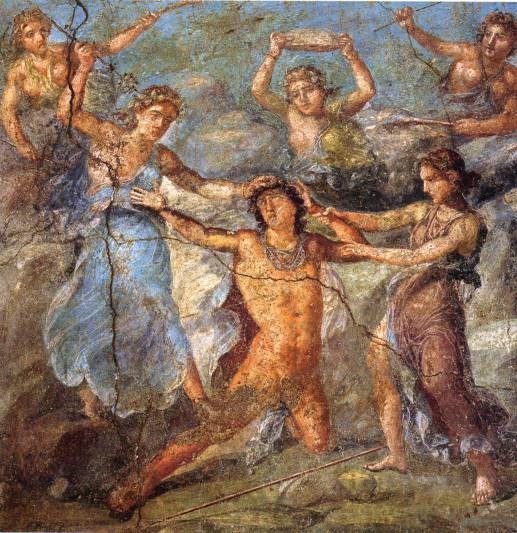
Penteo is quartered by the Bacchantes. House of the Vettii, Pompeii, Italy, XNUMXst century AD
When the three daughters of Preto, king of Tiryns, refused to participate in the mysteries of Dionysus, the god punished them by making them mad and making them wander the mountains at the mercy of erotic frenzies.
Just as the Bacchantes adopted a rather bloody behavior, since often their victims, animals or men they were, ended up in pieces, also the initiation of the adepts to the Dionysian mysteries implied particularly difficult tests to overcome.
The same sacrifices dedicated to Dionysus were often characterized by extreme violence, so as to include actual human sacrifices. Only in the annual festival of Orcomeno, dedicated to Dionysus, the victims were the same bacchae who were chased by the priest who had the right to kill the first of those he managed to reach.
Despite the advent of the Christian religion, some bloody rites attributed to the followers of the mysteries of Dionysus continued to exist. In Greece, near Thessaloniki, still today, on the anniversary of the saints, Constantine and Helena, a ritual is held, prohibited by the Orthodox church, which originates from the Dionysian initiation rites: some people in a frenzy perform dances on hot coals, waving crosses and prayer books [Ambrogio Donini: Brief history of religions p. 192].
The Myth of Dionysius in Sicily
SIRACUSA
In Sicily the cult of Dionysus therefore had a certain affinity with that of Demeter and Persephone. He flourished mainly in Syracuse where, in a temple of his, was housed a statue of Aristaeus which was stolen by Verres [Cicero, Verrine II.IV 128].
Selinunte
Even if in a lesser form, the cult of Dionysus was present in the rest of the island; of the three temples of Selinunte, traditionally designated with the letters of the alphabet E, F, and G, the temple designated by the letter F is attributed to the cult of Dionysus [Filippo Coarelli and Mario Torelli: Sicilia “Guide Archeologiche Laterza” p. 84.], confirmed by the discovery, in Selinunte, of a metope depicting Dionysus, now kept in the National Archaeological Museum of Palermo.
Note: The metope is a smooth panel between two triglyphs, it is typical of Doric architecture. It consists of a large block of stone (terracotta or marble) inserted in lateral grooves. The triglyph is an architectural element of the Doric temple, it is composed of a quadrangular slab that reproduces the ends of the beams resting on the architrave.
Religious syncretism
In Sicily, until a few years ago, residues of the bacchanalian forms could be seen in some religious festivals. Famous was the "calata d'imbriachi" where the veterans of the feast of Sant'Alfio di trecastagni, after having eaten, out of devotion to S. Alfio, baked sheep meat accompanied by abundant wine, they gave a show during the return journey in the various municipalities of Etna from where they had left. Pitrè, speaking of the drunken descent, said:
“See how many there is in a cart pulled by a poor donkey or a stuffed mule! See how they play, sing, shout, banging cymbals, banging tin saucers, tearing apart violins and guitars, blowing on whistles and jugs! Men lose their tongues from wine and sleep; their women more than them: and all with certain haunted faces, sagging and moving only to gasp in the air or to draw out words without construction and without meaning". [Giuseppe Pitrè: Patronal Festivals in Sicily. p. 239]
A Gratteri, in the province of Palermo (not far from Cefalù), the protector of the grape harvest and of the vine is S. Giacomo. During the patronal feast, the most beautiful bunches of grapes were offered to the statue of St. James, tying them to his silver stick. Moreover, wine in abundance was drunk during the procession and offered to the bearers of the statue; the effects of the wine drunk in honor of the saint were soon felt, thus characterizing the procession.
But the Christian saint who more than any other has taken the place of Dionysus, as the protector of wine, is undoubtedly St. Martin. The popular calendar celebrates this saint on November 11, precisely in the period in which the new wine is tasted, not surprisingly the motto that reads:
In San Martino Every must is wine
In Sicily a popular motto is even more explicit:
Cui si leva di vinu you say: long live Sammartinu!
During the Sicilian popular festivals in honor of S. Martino, the barrels with the new wine are opened and, always in his honour, the wine glasses are raised in competitions that resemble those once dedicated to Bacchus, there are many similarities with the Greek Anthesterias.
Extract from the Book ” Cults of Ancient Sicily” by Ignazio Caloggero ISBN: 9788832060102 © 2022 Centro Studi Helios srl



